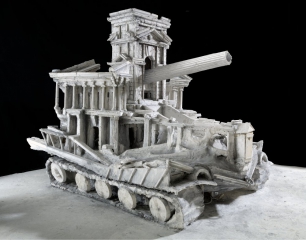After his impressive exhibition “Panthersprung” at Schultz Contemporary in Berlin, Alexander Seiler presents not only two of his both massive and grandiose ship sculptures at the Spinnerei (a former spinning mill) in Leipzig , but 6 further works. The exhibit “Triumph wieder Willen” (“Triumph against Will”)1 will be shown from 1 May to 13 June 2009. It will be opened on 30 April within the framework of the “spring tour” through the many galleries present at the location.
Until recently, the brilliant “Mutterschiff” (mother ship) could be admired in Berlin, as well as the “Totenschiff eines Oligarchen (SMS Adolf Merkle)” (“The Oligarch’s Death Ship (SMS Adolf Merkle)”). Whereas those two ships would be reason enough vor a visit, there is even more to see, e.g. the “Triumphtor auf Selbstfahrlafette” (“Self-propelled Triumphal Arch”), the “Regierungspalast (Vanessas Tempel)” (“Governmental Palace (Vanessa’s Temple)”), “7 Piratenschiffe” (“7 Pirate Ships”) and the “Rosenheimer Koffer” (“Rosenheim Suitcase”). With this work, Alexander Seiler established his “archisculptures”.
The exhibit “Triumph wider Willen” in the archiv massiv of Spinnerei Leipzig allows for many associations, beginning with its title. Its opening will be part of the annual “spring tour” through the galleries from 30 April to 2 May 2009. The press release can be quoted:
In his spaciously applied and delicately elaborated ‘archisculptures’, Seiler is discussing with the representation of sovereignty and power. For this purpose, he is availing himself of a wide range of historical references and questions to what an extent they may be translated into contemporary events.
Seiler produces his ‚archisculptures’ out of plaster as levitating miniatures of ships’ hulls and palace towers. Thus he remembers of the architecture of ancient temples and Egyptian pyramids, but also of prestigious buildings during the period of promoterism- in this time, the premises of this cotton spinning mill had been erected.
His works refer to the downside of imperialistic quest for conquest and its expression in form of war. Seiler ruptures the splendour of great times by designing his architectures partly ruined and crumbly. His “archisculptures” are therefore works that appear lordly, but nevertheless absorb traces and fractures of history. Are monuments – past and present – soever allegories or reluctant triumphs?
Alexander Seiler: “Triumph wider Willen”
Spinnerei
archiv massiv
Spinnereistr. 7, Haus 20A
04179 Leipzig
1 May – 13 June 2009
Tu-Sa 1100-1800h (during 1 and 2 May 1100-2000h)
Opening: 30 April 2009, 1700-2200h
- It is difficult to strike the right note on this translation, thus the one I chose is rather clumsy. The German original is surely playing with Riefenstahl’s “Triumph des Willens” (Triumph of the Will); literally translated, it would be “Unwilling Triumph”. ↩
